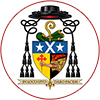As part of its quite radical reorganisation, in view of declining numbers, the Church of Scotland recently closed its long standing parish at Urquhart. Urquhart is a small village some 5 miles or so East of Elgin. There, some time between 1130 and 1150, King David founded a Benedictine Priory, established as a daughter house of Dunfermline Abbey. Apparently the first monks in Urquhart actually came all the way from Christ Church in Canterbury: itself the mother house of Dunfermline.
Urquhart Priory continued in existence, though certainly not without many disputes about its property and leadership, until the year 1453. (This, as it happens, was the year the last Emperor of Byzantium fell in the breach of his City walls, vainly attempting to resist the final Turkish assault). The buildings at Urquhart would seem by this time to have fallen into a sad state of disrepair, and the Choir monks (we never know about lay brothers) reduced in number to only two. Meanwhile at Pluscarden things were not much better. Almost certainly the Pluscarden Priory Church remained in a state of ruin after the attack of the Wolf of Badenoch in 1390, with Church services taking place in the Lady Chapel. So the Urquhart Prior, John de Benale, or Bonally, petitioned the Holy See for a union of the two houses.
The terms of this merger were that the Urquhart monks would move to Pluscarden, which would then cease to belong to the Valliscaulian Order, and become Benedictine. John de Benale would be Prior of the united community, and the last Valliscaulian Prior, Andrew Haag, would retire, with a pension.
The Pope’s permission granted, and the King (James II) offering no objection, the merger went ahead. Not all Pluscarden monks were happy with this arrangement. Some preferred to transfer to the Cistercians at Kinloss or Deer. Nevertheless, in the years that followed a great repair and re-building campaign was launched at Pluscarden. Presumably then the wrecked nave was abandoned. Elsewhere: many great open door arches and wide windows were drastically narrowed down with either dressed stone or rubble fill. The Pulpitum gallery overlooking the Transepts was constructed. Probably at this time also the Prior’s Lodge was built. The Pluscarden Church was anyway restored to use, and the one at Urquhart either plundered for its stone, or else simply left to moulder gently away. Certainly now there is no trace of it at all remaining, apart from the odd stone occasionally unearthed, or found as re-used in the vicinity.
One such stone has been part of the patrimony of Urquhart Kirk. The dissolving Urquhart congregation generously decided to donate it to Pluscarden: it came to us in July this year. A formal handover is expected to take place in due time, and the stone eventually given a sufficiently worthy setting, duly labelled for the information of visitors.
Figure 1- The Urquhart Stone
The Urquhart stone is decorated around its edge with a dog tooth ornamentation, that would perhaps not be unworthy of King David’s original masons in the 12th century. On its flat surface is roughly inscribed a Cross. The pattern of this Cross is very common on grave markers through the British Isles, dating from the later middle ages. We have several rather similar here at Pluscarden.
We may probably presume that the Urquhart stone was removed from its original position in the Priory building at some later date, and re-purposed in this way.
It is rather small for a grave marker: only about 2 feet and 2 inches long; about 1 foot 2 inches wide at the top, tapering down to 11 inches at the bottom. This contrasts with our own similar grave slabs, which are considerably larger: for example, about 4 feet 11 inches long; and about 2 feet 6 inches wide at the broadest point. On the other hand, the Urquhart stone has a depth of about 5 and a half inches. Contrast the Pluscarden ones, that are only about 2 and a half inches deep.
In response to enquiry, Historic Environment Scotland note for us the unprofessional quality of the carving. They say that the depiction of the cross arms, giving the impression of bundled rods, is unusual. The diagonal lines surrounding the lower part of the Cross are also atypical, but are reminiscent of geometrical decoration on slabs at Airlie, Angus, and St Nicholas, Aberdeen. Maybe here the mason was simply reluctant to leave the space void? The long object beside the calvary base is hard to identify. Maybe it’s intended as an instrument of the Passion? Or maybe as a symbol of the occupation of the unnamed deceased?
Below is a picture of a Pluscarden grave slab, now placed upright with others against the wall in our North Transept. The stepped base of the Cross is similar to that on the Urquhart stone. The heart, and the A and O in Gothic lettering surely point to a period before the Reformation.
Figure 2: A Pluscarden Grave Slab I
Two other Pluscarden grave slabs, pictured below, are incomplete, but we see on them very similar features; also clearly pointing to a pre-Reformation provenance. The last example shown here (Figure 4- A Pluscarden Grave Slab III), with an IHS (“Iesus Salvator Hominum”) in the centre of the Cross, is named and dated, as can still be made out in the Gothic lettering. This slab commemorates “Dominus Wilhelmus de Burnet” who died in 1480. The book and chalice inscribed beside the Cross perhaps indicate that he was a Deacon? “Burnet” is a common local name. Nearby Birnie was at the time written sometimes as “Byrneth”.
It is anyway a very nice thing to have possession of this concrete link with what was a Sister Priory some 600 years ago.
Figure 3- A Pluscarden Grave Slab II
Figure 4- A Pluscarden Grave Slab III




